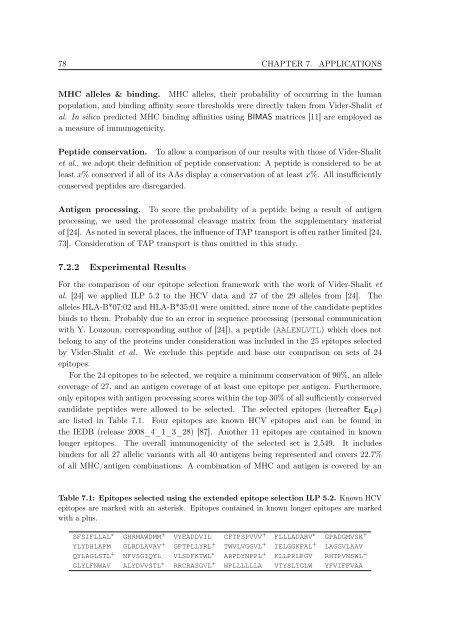New Approaches to in silico Design of Epitope-Based Vaccines
New Approaches to in silico Design of Epitope-Based Vaccines
New Approaches to in silico Design of Epitope-Based Vaccines
Create successful ePaper yourself
Turn your PDF publications into a flip-book with our unique Google optimized e-Paper software.
78 CHAPTER 7. APPLICATIONS<br />
MHC alleles & b<strong>in</strong>d<strong>in</strong>g. MHC alleles, their probability <strong>of</strong> occurr<strong>in</strong>g <strong>in</strong> the human<br />
population, and b<strong>in</strong>d<strong>in</strong>g aff<strong>in</strong>ity score thresholds were directly taken from Vider-Shalit et<br />
al. In <strong>silico</strong> predicted MHC b<strong>in</strong>d<strong>in</strong>g aff<strong>in</strong>ities us<strong>in</strong>g BIMAS matrices [11] are employed as<br />
a measure <strong>of</strong> immunogenicity.<br />
Peptide conservation. To allow a comparison <strong>of</strong> our results with those <strong>of</strong> Vider-Shalit<br />
et al., we adopt their def<strong>in</strong>ition <strong>of</strong> peptide conservation: A peptide is considered <strong>to</strong> be at<br />
least x% conserved if all <strong>of</strong> its AAs display a conservation <strong>of</strong> at least x%. All <strong>in</strong>sufficiently<br />
conserved peptides are disregarded.<br />
Antigen process<strong>in</strong>g. To score the probability <strong>of</strong> a peptide be<strong>in</strong>g a result <strong>of</strong> antigen<br />
process<strong>in</strong>g, we used the proteasomal cleavage matrix from the supplementary material<br />
<strong>of</strong> [24]. As noted <strong>in</strong> several places, the <strong>in</strong>fluence <strong>of</strong> TAP transport is <strong>of</strong>ten rather limited [24,<br />
73]. Consideration <strong>of</strong> TAP transport is thus omitted <strong>in</strong> this study.<br />
7.2.2 Experimental Results<br />
For the comparison <strong>of</strong> our epi<strong>to</strong>pe selection framework with the work <strong>of</strong> Vider-Shalit et<br />
al. [24] we applied ILP 5.2 <strong>to</strong> the HCV data and 27 <strong>of</strong> the 29 alleles from [24]. The<br />
alleles HLA-B*07:02 and HLA-B*35:01 were omitted, s<strong>in</strong>ce none <strong>of</strong> the candidate peptides<br />
b<strong>in</strong>ds <strong>to</strong> them. Probably due <strong>to</strong> an error <strong>in</strong> sequence process<strong>in</strong>g (personal communication<br />
with Y. Louzoun, correspond<strong>in</strong>g author <strong>of</strong> [24]), a peptide (AALENLVTL) which does not<br />
belong <strong>to</strong> any <strong>of</strong> the prote<strong>in</strong>s under consideration was <strong>in</strong>cluded <strong>in</strong> the 25 epi<strong>to</strong>pes selected<br />
by Vider-Shalit et al. We exclude this peptide and base our comparison on sets <strong>of</strong> 24<br />
epi<strong>to</strong>pes.<br />
For the 24 epi<strong>to</strong>pes <strong>to</strong> be selected, we require a m<strong>in</strong>imum conservation <strong>of</strong> 90%, an allele<br />
coverage <strong>of</strong> 27, and an antigen coverage <strong>of</strong> at least one epi<strong>to</strong>pe per antigen. Furthermore,<br />
only epi<strong>to</strong>pes with antigen process<strong>in</strong>g scores with<strong>in</strong> the <strong>to</strong>p 30% <strong>of</strong> all sufficiently conserved<br />
candidate peptides were allowed <strong>to</strong> be selected. The selected epi<strong>to</strong>pes (hereafter EILP)<br />
are listed <strong>in</strong> Table 7.1. Four epi<strong>to</strong>pes are known HCV epi<strong>to</strong>pes and can be found <strong>in</strong><br />
the IEDB (release 2008_4_1_3_28) [87]. Another 11 epi<strong>to</strong>pes are conta<strong>in</strong>ed <strong>in</strong> known<br />
longer epi<strong>to</strong>pes. The overall immunogenicity <strong>of</strong> the selected set is 2,549. It <strong>in</strong>cludes<br />
b<strong>in</strong>ders for all 27 allelic variants with all 40 antigens be<strong>in</strong>g represented and covers 22.7%<br />
<strong>of</strong> all MHC/antigen comb<strong>in</strong>ations: A comb<strong>in</strong>ation <strong>of</strong> MHC and antigen is covered by an<br />
Table 7.1: Epi<strong>to</strong>pes selected us<strong>in</strong>g the extended epi<strong>to</strong>pe selection ILP 5.2. Known HCV<br />
epi<strong>to</strong>pes are marked with an asterisk. Epi<strong>to</strong>pes conta<strong>in</strong>ed <strong>in</strong> known longer epi<strong>to</strong>pes are marked<br />
with a plus.<br />
SFSIFLLAL ∗ GHRMAWDMM + VYEADDVIL CFTPSPVVV + FLLLADARV ∗ GPADGMVSK +<br />
YLYDHLAPM GLRDLAVAV + GPTPLLYRL + TWVLVGGVL + IELGGKPAL + LAGGVLAAV<br />
QYLAGLSTL + NFVSGIQYL VLSDFKTWL ∗ ARPDYNPPL + KLLPRLPGV RHTPVNSWL +<br />
GLYLFNWAV ALYDVVSTL ∗ RRCRASGVL + WPLLLLLLA VTYSLTGLW YFVIFFVAA

















